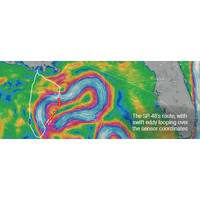
SeaTrac USV Completes GoM Data Harvesting Project
more. However, collecting such data at sea via traditional manned vessels brings risk to on-board crews and generates high operational costs, while also emitting harmful greenhouse gases.Representing the first of four project phases for the University of Rhode Island (URI), funded by the U.S. National Academy of Sciences, this initial mission demonstrated the feasibility and benefits of using SeaTrac’s USV equipped with Sonardyne’s advanced acoustic technology in lieu of manned vessels to collect data from offshore seabed sensors.SeaTrac’s SP-48 USV is a solar- and battery-powered vehicle
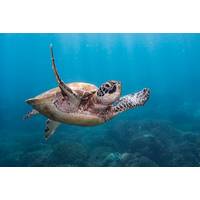
Marine Animals Travel at Depth that Minimizes Wave Formation
.It has long been known that additional drag from wave creation minimizes once a travelling object is at depths greater than three times its diameter, but it was hard to compare with travel depths of wild animals due to tracking limitations.In this new study published in Proceedings of the National Academy of Sciences (PNAS) near surface swim depths were recorded to within 1.5 centimeters in little penguin and loggerhead turtles, along with motion data and video footage from animal borne cameras. This was compared with satellite tracking data for long-distance migrations in green turtles and data from

WHOI’s Benjamin Van Mooy Awarded 'Genius Grant'
institution ever since, including serving as Chair of the Marine Chemistry and Geochemistry Department before his recent appointment as Interim Vice President for Science and Engineering. He has published in a variety of scientific journals, including Science, Nature, and Proceedings of the National Academy of Sciences, among others. He received the G. Evelyn Hutchinson Award from the Association for the Sciences of Limnology and Oceanography in 2022 and is a Simons Foundation SCOPE Investigator as well as a Kavli Frontiers of Science Fellow
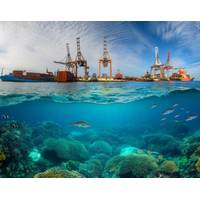
Restoring Marine Habitats and Port Decarbonization
Coastal Ecosystems from Fisheries and Aquaculture Impacts. Treatise on Estuarine and Coastal Science, 10, 165-187.16.Williams, S., Ambo-Rappe, R., Sur, C., Abbott, J., & Limbong, S. (2017). Species richness accelerates marine ecosystem restoration in the Coral Triangle. Proceedings of the National Academy of Sciences, 114, 11986 - 11991.17.Guannel, G., Arkema, K., Ruggiero, P., & Verutes, G. (2016). The Power of Three: Coral Reefs, Seagrasses and Mangroves Protect Coastal Regions and Increase Their Resilience. PLoS ONE, 11.18.Mcleod, E., Chmura, G. L., Bouillon, S., Salm, R., Björk, M., Duarte

The Potential of Restoring Marine Habitats
Coastal Ecosystems from Fisheries and Aquaculture Impacts. Treatise on Estuarine and Coastal Science, 10, 165-187.16.Williams, S., Ambo-Rappe, R., Sur, C., Abbott, J., & Limbong, S. (2017). Species richness accelerates marine ecosystem restoration in the Coral Triangle. Proceedings of the National Academy of Sciences, 114, 11986 - 11991.17.Guannel, G., Arkema, K., Ruggiero, P., & Verutes, G. (2016). The Power of Three: Coral Reefs, Seagrasses and Mangroves Protect Coastal Regions and Increase Their Resilience. PLoS ONE, 11.18.Mcleod, E., Chmura, G. L., Bouillon, S., Salm, R., Björk, M., Duarte
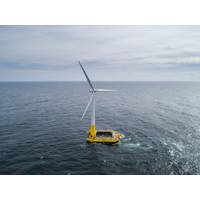
Floating Offshore Wind: New Seascape, New Challenges
on European experiences and documents. For reference, Wise cited the “White Paper on Offshore Wind Energy” written by the Netherlands’ Ministry of Infrastructure and the Environment and The Ministry of Economic Affairs in 2014.Readers may recall that in February 2022 the National Academy of Sciences released a study sponsored by BOEM that documented how wind towers degrade maritime radar. Turbines clutter a radar’s display, resulting in an ambiguous and confusing picture for the operator, according to the NAS report.Wise was asked about developments pertaining to radar-wind
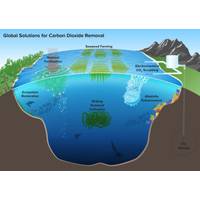
Carbon Dioxide Removal (CDR) ... To Clear the Air, Look Beneath the Waves
phenomenon is ocean CDR—the field researching and developing technology to aid and expedite the ocean’s natural carbon sink processes, remove significant amounts of carbon from the atmosphere and make the 1.5°C goal more attainable.Six degrees of decarbonizationAccording to the National Academy of Sciences, Engineering and Medicine (NASEM), there are currently six main ocean CDR techniques: 1) seaweed farming to increase green space that needs CO2 to grow, 2) nutrient fertilization to enhance phytoplankton growth and uptake of CO2, 3) ecosystem restoration to move carbon dioxide through
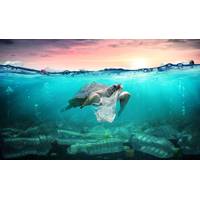
Opinion: Let's Get the Plastic Out of Our Lives (& Waterways)
that's easy to ignore. Last year, I contributed the U.S. average-per-person 300 pounds of plastic garbage to wherever it went after convenient curbside pickup. So out of sight, out of mind, right? Not really, but does it matter? Yes, it does.In a fascinating recent report, the National Academy of Sciences, Engineering, and Medicine politely told us that we're choking ourselves to death on manufactured plastic waste and that 80% of the harmful plastic in the ocean comes from land-based sources.It's the micro-plastics, smaller than 5 mm (the size of a sesame seed) and nano-plastics
Maritime Risk Symposium: Registration is Now Open
The University of Houston’s College of Technology will host the 12th Annual Maritime Risk Symposium, a virtual event, in collaboration with the National Academy of Sciences from November 1-5, 2021.The Maritime Risk Symposium is an annual conference in which government and maritime industry leaders, port representatives, researchers, and solution providers convene to examine current and emerging threats to maritime security.RegistrationRegistration for this year’s virtual Maritime Risk Symposium has been reduced to $50 per person. Registrants will receive a personalized code to participate


 February 2025
February 2025





